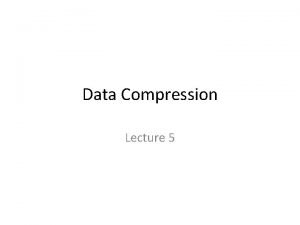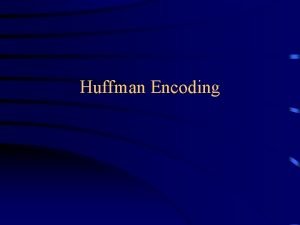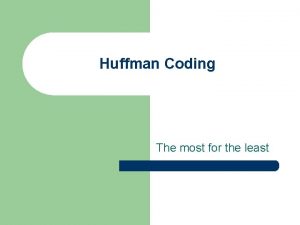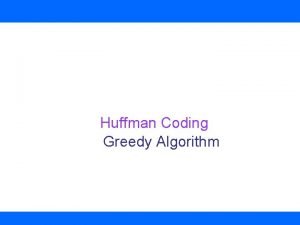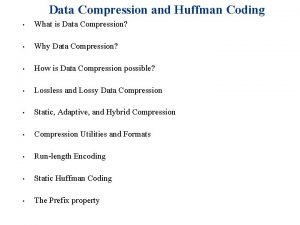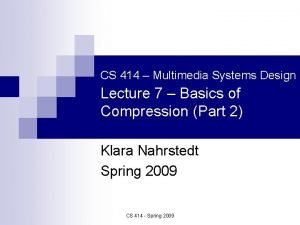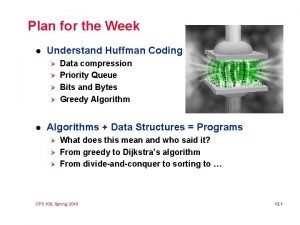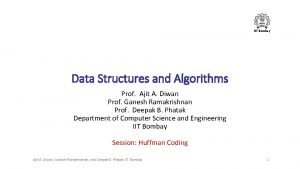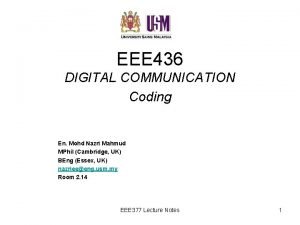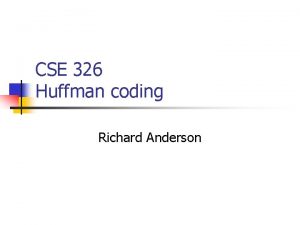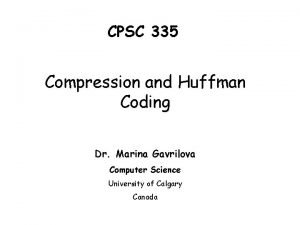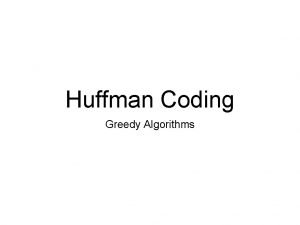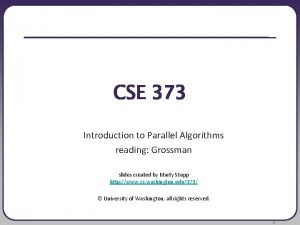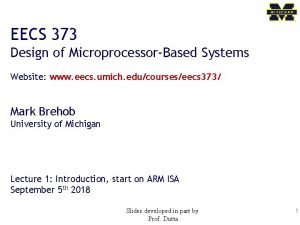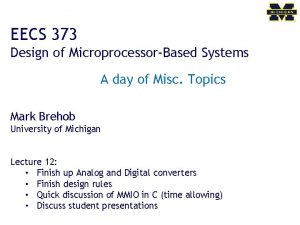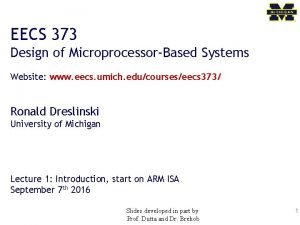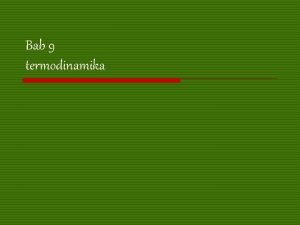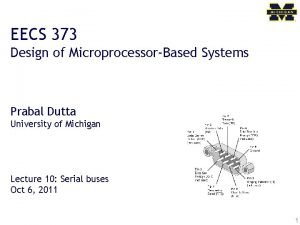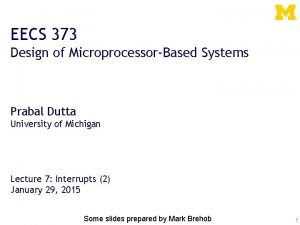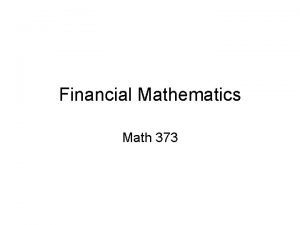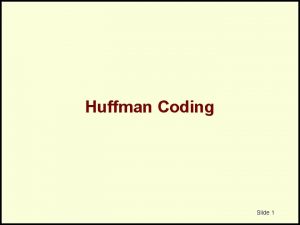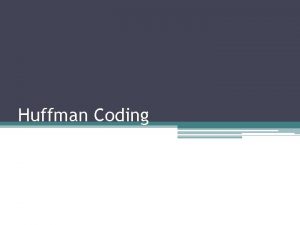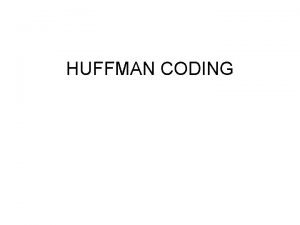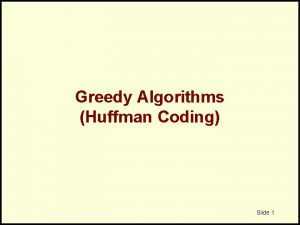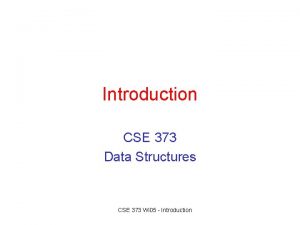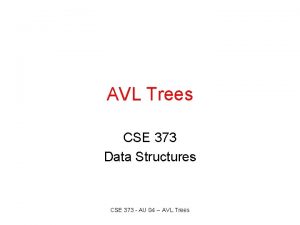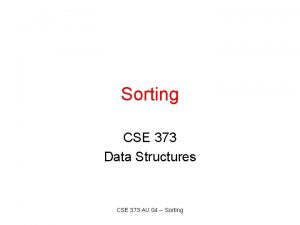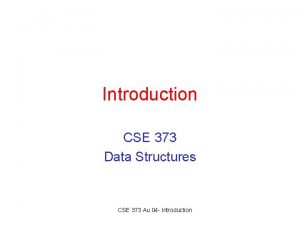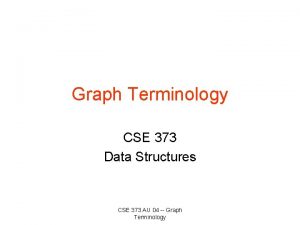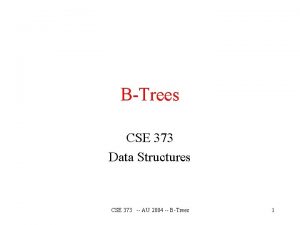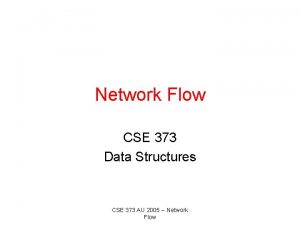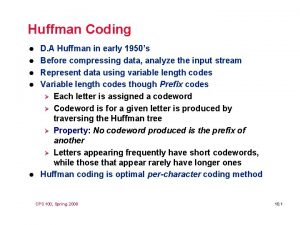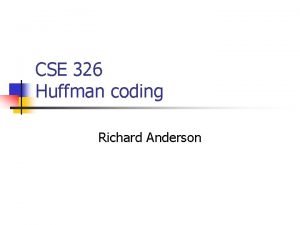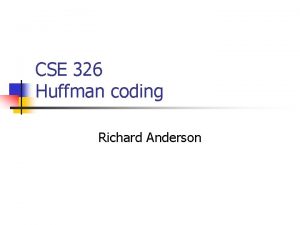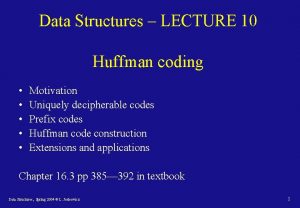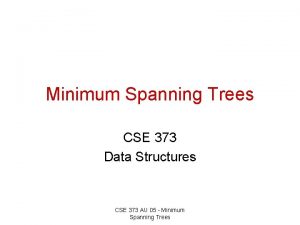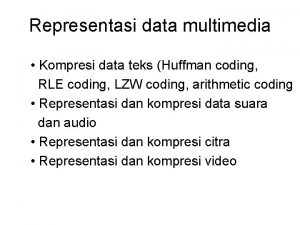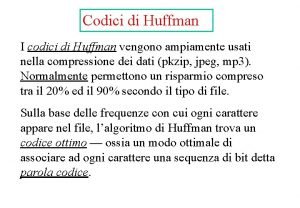Huffman Coding CSE 373 Data Structures CSE 373





























- Slides: 29

Huffman Coding CSE 373 Data Structures CSE 373 AU 04 -- Huffman Coding

Reading • Reading › Goodrich and Tamassia, Chapter 11, section 11. 4, pp. 567 -569. 8/29/2021 CSE 373 AU 04 -- Huffman Coding 2

Outline Motivation Character occurrence in documents: Frequency Tables Huffman trees Huffman codes Decoding 8/29/2021 CSE 373 AU 04 -- Huffman Coding 3

Motivation • Documents typically have a certain amount of redundancy in their representation in a computer. • ASCII and other conventional character codes use equal numbers of bits for each character. • If certain symbols (characters) occur a lot more frequently than others, then let’s use shorter bit sequences for them, (although that will mean longer bit sequences for the less frequent characters). • Huffman coding provides the optimal assignment of numbers of bits to the different characters. 8/29/2021 CSE 373 AU 04 -- Huffman Coding 4

Frequency Tables “For years an oven course ages” 8/29/2021 CSE 373 AU 04 -- Huffman Coding a: 3 c: 1 e: 4 F: 1 g: 1 n: 2 o: 3 r: 3 s: 3 u: 1 v: 1 y: 1 Blank: 5 5

Huffman Trees A Huffman Tree is a binary tree having the following properties: Each leaf node contains a symbol (a character) and a frequency value. Each internal node contains a frequency (the sum of its children’s frequencies). 8/29/2021 CSE 373 AU 04 -- Huffman Coding a: 2 c: 1 e: 4 F: 1 g: 1 n: 1 o: 3 r: 3 s: 3 u: 1 v: 1 Blank: 5 6

Huffman Tree Construction To build a Huffman tree, do the following: Step 1: Initialize a forest of binary trees, with one-node tree per character occurring in the document. Each of these is a leaf node, so it gets labeled with the character and the frequency. Step 2: (a) Select a minimum-frequency Huffman tree from the forest. Call it A. Select the a second minimum-frequency Huffman tree from those remaining. Call it B. Remove A and B from the forest. (b) Combine A and B by creating a new node C, and making A the left subtree of C and B the right subtree of C. Label C with the sum of the frequencies of A and B. (c) Put the new tree, rooted at C back into the forest. Step 3: Repeat step 2 until only a single tree remains. Output this tree. 8/29/2021 CSE 373 AU 04 -- Huffman Coding 7

Example, Step 1: a: 3, c: 1, e: 4, F: 1, g: 1, n: 2, o: 3, r: 3, s: 3, u: 1, v: 1, y: 1, Blank: 5 The intial forest contains 13 trees of one leaf node each. a c e F g n o r s u v y Blank 3 1 4 1 1 2 3 3 3 1 1 1 5 8/29/2021 CSE 373 AU 04 -- Huffman Coding 8

Example, Step 2 a: c F 1 1 Removal of two minimum-frequency trees from the forest. a e g n o r s u v y Blank 3 4 1 2 3 3 3 1 1 1 5 8/29/2021 CSE 373 AU 04 -- Huffman Coding 9

Example, Step 2 b: 2 c F 1 1 Combining the two, using a new root node. a e g n o r s u v y Blank 3 4 1 2 3 3 3 1 1 1 5 8/29/2021 CSE 373 AU 04 -- Huffman Coding 10

Example, Step 2 c: Adding the new tree to the forest. There are now only 12 trees in the forest. 2 a c F e g n o r s u v y Blank 3 1 1 4 1 2 3 3 3 1 1 1 5 8/29/2021 CSE 373 AU 04 -- Huffman Coding 11

Example, Next iteration: Two more trees have been merged. 2 2 a c F e g u n o r s v y Blank 3 1 1 4 1 1 2 3 3 3 1 1 5 8/29/2021 CSE 373 AU 04 -- Huffman Coding 12

Example, Third iteration: There are now 10 trees in the forest. 2 2 2 a c F e g u n o r s v y Blank 3 1 1 4 1 1 2 3 3 3 1 1 5 8/29/2021 CSE 373 AU 04 -- Huffman Coding 13

Example, Fourth iteration: There are now 9 trees in the forest. 4 2 2 2 c F g u a e n o r s v y Blank 1 1 3 4 2 3 3 3 1 1 5 8/29/2021 CSE 373 AU 04 -- Huffman Coding 14

Example, 5 th iteration: There are now 8 trees in the forest. 4 4 2 2 2 Blank c F g u a e n v y o r s 1 1 3 4 2 1 1 3 3 3 8/29/2021 CSE 373 AU 04 -- Huffman Coding 15 5

Example, 6 th iteration: There are now 7 trees in the forest. 4 4 2 2 6 2 Blank c F g u a o e n v y r s 1 1 3 3 4 2 1 1 3 3 8/29/2021 CSE 373 AU 04 -- Huffman Coding 16 5

Example, 7 th iteration: There are now 6 trees in the forest. 4 4 2 2 6 Blank c F g u a o e n v y r s 1 1 3 3 4 2 1 1 3 3 8/29/2021 CSE 373 AU 04 -- Huffman Coding 17 5

Example, 8 th iteration: There are now 5 trees in the forest. 8 4 4 2 2 2 6 6 Blank c F g u n v y a o e r s 1 1 2 1 1 3 3 4 3 3 8/29/2021 CSE 373 AU 04 -- Huffman Coding 18 5

Example, 9 th iteration: There are now 4 trees in the forest. 8 4 4 2 2 2 9 6 6 c F g u n v y e Blank a o r s 1 1 2 1 1 4 5 3 3 8/29/2021 CSE 373 AU 04 -- Huffman Coding 19

Example, 10 th iteration: There are now 3 trees in the forest. 8 4 12 4 2 2 2 9 6 6 c F g u n v y e Blank a o r s 1 1 2 1 1 4 5 3 3 8/29/2021 CSE 373 AU 04 -- Huffman Coding 20

Example, 11 th iteration: There are now 2 trees in the forest. 17 8 4 12 4 2 2 2 9 6 6 c F g u n v y e Blank a o r s 1 1 2 1 1 4 5 3 3 8/29/2021 CSE 373 AU 04 -- Huffman Coding 21

Example, 12 th (last) iteration: There is now only one tree in the forest. 29 17 8 4 12 4 2 2 2 9 6 6 c F g u n v y e Blank a o r s 1 1 2 1 1 4 5 3 3 8/29/2021 CSE 373 AU 04 -- Huffman Coding 22

Example, Assign Edge Labels: 0 on left edges, 1 on right edges. 0 8 0 4 0 0 c 1 F 1 1 8/29/2021 1 4 2 0 1 1 17 1 1 2 29 0 0 1 2 0 g u n 0 v 1 1 2 1 9 1 6 1 0 y e Blank 1 4 5 CSE 373 AU 04 -- Huffman Coding 12 1 0 6 1 0 1 a o r s 3 3 23

Example, Coding Table: a: 100 c: 00000 e: 010 F: 00001 g: 00010 n: 0010 o: 101 r: 110 s: 111 u: 00011 v: 00110 y: 00111 Blank: 011 8/29/2021 CSE 373 AU 04 -- Huffman Coding 24

Example, The Document, Coded: a: 100 c: 00000 e: 010 F: 00001 g: 00010 n: 0010 o: 101 r: 110 s: 111 u: 00011 v: 00110 y: 00111 Blank: 011 8/29/2021 00011011100111010100110111000010 011101001000100110000010100011110111 01001110000010010111 Formatted with spaces after each letter and breaks after each blank: 0001 110 011 00111 010 100 111 011 100 0010 011 101 00110 0010 011 00000 101 00011 110 111 010 011 100 00010 111 For years an oven course ages CSE 373 AU 04 -- Huffman Coding 25

Example, Decoding: a: 100 c: 00000 e: 010 F: 00001 g: 00010 n: 0010 o: 101 r: 110 s: 111 u: 00011 v: 00110 y: 00111 Blank: 011 8/29/2021 Use the Huffman tree as a decoding aid, starting at the root and following the edge left or right depending on whether the current next symbol in the code is a 0 or a 1. When you reach a leaf, output the character there, and start processing the next symbol from the root again. 00011011100111010100110111000010 011101001000100110000010100011110111 01001110000010010111 Huffman codes are “prefix codes” and there is never any ambiguity about how to process the next symbol. CSE 373 AU 04 -- Huffman Coding 26

Compression Ratio The coded document uses 100 bits*. The 8 -bit ASCII version requires 29*8 = 232 bits. The compression ratio is 100/232 = 0. 4310 (*Not including the coding table) 8/29/2021 CSE 373 AU 04 -- Huffman Coding 27

Efficient Implementation While constructing the Huffman tree, maintain a priority queue that holds the forest of trees. This makes it easy to obtain the minimum frequency tree using FINDMIN and DELETEMIN. 8/29/2021 CSE 373 AU 04 -- Huffman Coding 28

Closing Remarks Huffman Coding is an important data compression method. It can be applied to text, images or any data that can be described as a sequence of symbols from a fixed set of symbols. It is often used as part of other systems, such as the JPEG image compression method. 8/29/2021 CSE 373 AU 04 -- Huffman Coding 29
 Open coding dan axial coding
Open coding dan axial coding Contoh open coding, axial coding selective coding
Contoh open coding, axial coding selective coding Huffman
Huffman Huffman coding example with probabilities
Huffman coding example with probabilities Huffman code visualization
Huffman code visualization Huffman entropy
Huffman entropy Huffman coding example with probabilities
Huffman coding example with probabilities Huffman coding using greedy algorithm
Huffman coding using greedy algorithm Coding
Coding Huffman coding example with probabilities
Huffman coding example with probabilities Huffman code pseudocode
Huffman code pseudocode Huffman encoding visualizer
Huffman encoding visualizer Objective fidelity criteria
Objective fidelity criteria Huffman encoding trie
Huffman encoding trie Huffman coding
Huffman coding Huffman coding
Huffman coding Cse 326
Cse 326 Huffman coding
Huffman coding Prefix free
Prefix free Cse 373
Cse 373 History of qualitative research
History of qualitative research Coding dna and non coding dna
Coding dna and non coding dna Analogous structures
Analogous structures Eecs373
Eecs373 Eecs 373
Eecs 373 Eecs 373
Eecs 373 Suatu sistem menyerap kalor 1500 kalori dari lingkungannya
Suatu sistem menyerap kalor 1500 kalori dari lingkungannya Eecs 373
Eecs 373 Eecs 373
Eecs 373 Math 373
Math 373


